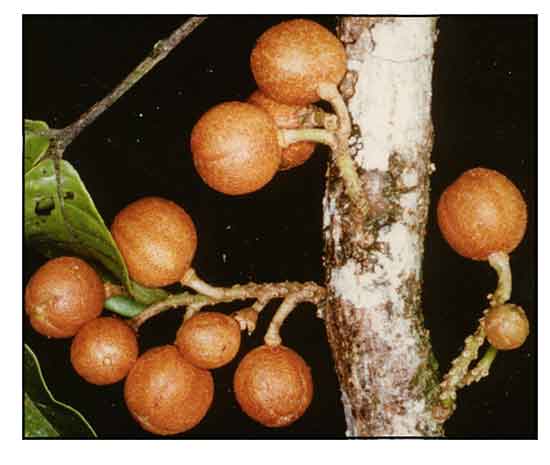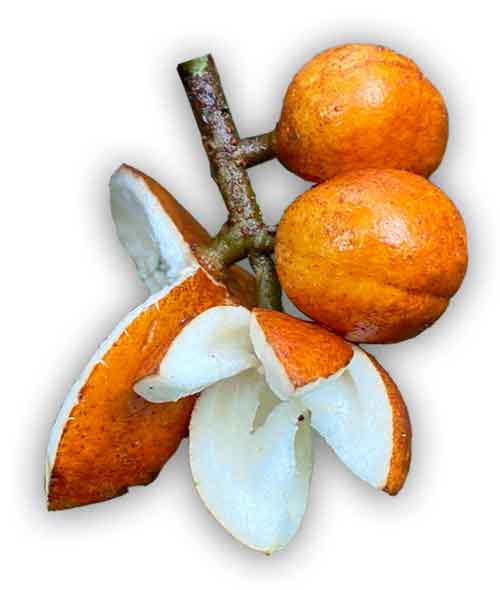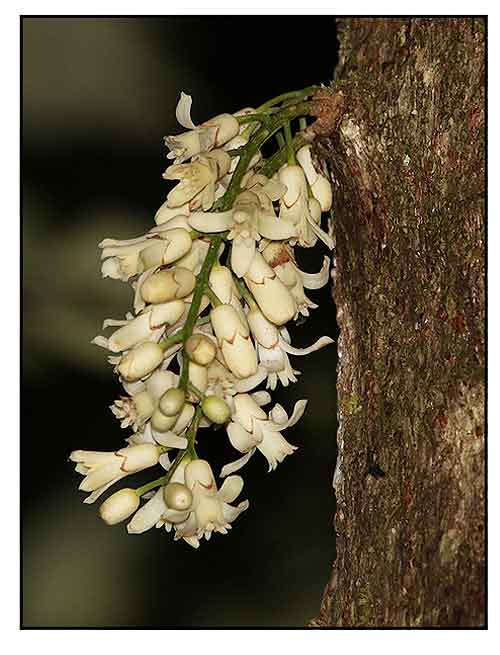 Gen info Gen info
- Epicharis parasitica, commonly known as yellow mahogany, is a species of rainforest tree in the family Meliaceae.
- Species was first described by Swedish naturalist Pehr Osbeck as Melia parasitica, published in 1757 in his book Dagbok ofwer en Ostindisk Resa aren. It was transferred to the genus Dysoxylum by Indonesian botanist André Joseph Guillaume Henri Kostermans in 1966. (2)
- Etymology: The genus name Dysoxylum derives from Latin dys meaning 'bad', and Ancient Greek xylon meaning 'wood', referring to the unpleasant smell emitted by some species. The species epithet parasiticus derives from Latin meaning 'parasitic', referring to Osbeck's early mistaken belief that the flowers were parasitic. (2)
- Flowers are visited by butterflies, an important pollinator of the family. (2)
 Botany Botany
• Epicharis parasitica grows up to 36 m (118 ft) tall with a trunk diameter of up to 60 cm (24 in). Buttresses may be present, growing up to 1.5 m (4 ft 11 in) tall and wide. Bark is yellowish to grey-brown, and smooth to flaky with scattered lenticels. Leaves are compound, arranged spirally on the twigs and measure up to 1.5 m (4 ft 11 in) long with up to 19 leaflets. Leaflets are oblong to ovate in shape and up to 19 cm (7.5 in) long by 6 cm (2.4 in) wide, with about 14 lateral veins each side of the midrib. Inflorescence is a raceme up to 30 cm (12 in) long, growing from protrusions on the trunk of the tree in a process called cauliflory, or from woody branches (ramiflory). Sweetly scented flowers are white or cream with four petals. White staminal tube measures about 15 mm (0.59 in) long and 4 mm (0.16 in) wide. Fruit is a globose red-brown capsule about 4 to 5 cm (1.6 to 2.0 in) diameter, containing up to four segments with one seed contained in each. Seeds are about 2 cm (0.79 in) long, brownish-black and with an orange-red sacrotesta. (2)
Distribution
- Native to the Philippines.
- In Leyte, Apayao, Cagayan Isabela, Laguna, Quezon, Sorsogon. (3)
- Also native to Bismarck Archipelago, Borneo, Jawa, Lesser Sunda Is., Malaya, Maluku, New Guinea, Queensland, Solomon Is., Sulawesi, Sumatera, Taiwan. (1)
- Grows well in developed rainforest, including on limestone, at sea level to around 2,100 m altitude. (2)
In the Philippines, in lowland primary forests, ascending to 1,000 m. (3)
 Constituents Constituents
- LC-MS/MS study of leaf extracts identified bioactive components, including stylosin, capillartemisin A. 19ß-glucosyl-14-deoxy-11,12-didehydroandrographoside, daturametelin H, stigmas-3,6-dione, 2α,3β,4α-trihy- droxy nortropane and arnebinone. (see study below) (4)
- Study of stem bark isolated two undescribed sesquiterpenoid derivatives, 10β,11-dihydroxy-1β-hydroperoxide-4αH,5αH,7βH-guaiane (1) and 10β-hydroxy-4α,4β-dimethyl-5αH,7αH-eudesm-3-one (2) along with three known of guaiane, aroma-dendrane, and cadinane sesquiterpenoids (3-5). (see study below) (5)
- Study of leaves of Dysoxylum parasiticum isolated two new sesquiterpene phenol trimers,
tridysoxyphenols A (2) and B (3), along with two known compounds, namely a sesquiterpene phenol, (+)-7-hydroxycalamenene (1), and a tetralone derivative, 4-hydroxy-4,7-dimethyl-α-tetralone (4). (see study below) (6)
- Study of leaves isolated three new sesquiterpene phenol dimers, bidysoxyphenols A-C (2-4), along with two known compounds, sesquiterpene phenol (1) and ionone derivatives (5). (see study below) (8)
- Study of stem bark isolated seven previously undescribed preurianin-type liminoids, named paraxyliines A-G. and three known analogs. (see study below) (9)
- Study of leaves isolated a new bicoumarin derivative, bidysoxyletine (1). The compound possessed a dibenzonapthyrone skeleton. (10)
- Phytochemical screening of aqueous leaf extract yielded alkaloids, glycosides, flavonoids, tannins, saponins, phenolic compounds, with absence of reducing sugar, terpenoid and steroid. (see study below)
(11)
- Study of stem bark isolated two underscribed sesquiterpenoids, dysoticans A and B, and three undescribed sesquiterpenoid dimers, dysoticans C-E, together with six analogs. (14)
- Phytochemical screening of leaves yielded alkaloid, flavonoid, saponin, and tannins; pulp yielded flavonoids, with absence of allkaloid, saponin, and tannin.
Properties
- Studies suggest antioxidant, antidiabetic, α-glucosidase inhibitory, immunomodulatory, antimalarial, preservative properties.
Parts used
Leaves, stem bark.
Uses
Edibility
- No study or report found on human consumption.
- Javan gibbons consume leaves and fruits of the plant. (15)
Folkloric
- No reported folkloric medicinal use in the Philippines.
- In Papua New Guinea, decoction of leaves used to treat malaria and respiratory diseases. Raw bark used to treat sores and ulcers. (6)
- In West Java, plant used for treatment of stomach pains and other gastric problems.
Others
- Wood: Heartwood is red; sapwood white. Suitable for medium and heavy construction, for planking, flooring, panelling, furniture, wood pallets, veneer. and plywood. (16)
Studies
• Antioxidant / α-Glucosidase Inhibitory / Leaves: Study evaluated extracts of dried powdered leaves for phenolic content, antioxidant, and antidiabetic activities. The ethyl acetate extract showed highest phenolic content at 21.54 mg gallic acid equivalents/g dw. The EA extract showed potent antioxidant activity with IC50 of 30.72 µg/ml and α-glucosidase inhibitory activity with IC50 of 16.32 µg/mL. Traditional use is validated by its antioxidant and antidiabetic potential, which is attributed to its phenolic content. (see constituents above) (4)
• Cytotoxic Sesquiterpenoids / Stem Bark: Study of stem bark isolated two undescribed sesquiterpenoid derivatives, 10β,11-dihydroxy-1β-hydroperoxide-4αH,5αH,7βH-guaiane (1) and 10β-hydroxy-4α,4β-dimethyl-5αH,7αH-eudesm-3-one (2) along with three known of guaiane, aroma-dendrane, and cadinane sesquiterpenoids (3-5). Isolated compounds were tested for cytotoxic properties against MCF-7 breast cancer line. Compound 4 showed strongest cytotoxic activity with IC50 of 12.17 µM, while other compounds showed moderate or no activity. (5)
• Sesquiterpene Phenols / Leaves: Study of leaves of Dysoxylum parasiticum isolated two new sesquiterpene phenol trimers along with two known compounds. No cytotoxic activity was observed for any of the isolated compounds, although compound 1, (+)-7-hydroxycalamenene, a sesquiterpene phenol, suppressed viability of HL60 cells at 119.85 µM. (see constituents above) (6)
• Immunomodulatory / Anti-Inflammatory / Sesquiterpenoids / Stem Bark: Study evaluated the immunomodulatory effects of sesquiterpenoids (SQs) and sesquiterpenoid dimers (SQDs) from Dysoxylum parasiticum stem bark on human and murine cells, focusing on toll-like receptor 4 (TLR4). Secreted alkaline phosphatase assay (SEAP) identified antagonist TLR4 compounds, including SQs 6, 9, and 10, and SQDs 17 and 22. SQ9 (10-hydroxyl-15-oxo-α-cadinol) showed potent ability to reduce TLR4 activation induced by LPS stimulation. SEAP assay also revealed diverse immune regulatory effects for the same ligand. Selected SQs and SQDs exhibited partial antagonistic effect exclusively on murine TLR4 and showed dose-dependent effect on the production of proinflammatory cytokines. (7)
• Cytotoxicity against Leukemia Cells / Bidysoxyphenols / Leaves: Study of leaves isolated three new sesquiterpene phenol dimers, bidysoxyphenols A-C (2-4), along with two known compounds, sesquiterpene phenol (1) and ionone derivatives (5). Compounds 1 and 2 showed cytotoxicity against human promyelocytic leukemia cells, with IC50s of 18.25 and 39.04, respectively. (8)
• Paraxylines / Immunomodulatory and Cytotoxic / Stem Bark: Study of stem bark isolated seven previously undescribed preurianin-type liminoids, named paraxyliines A-G. and three known analogs. Secreted alkaline phosphatase assay showed paraxyline B to have remarkable TLR4 agonist activity, whereas two analogs (toonapubesins A and B) were found to antagonize lipopolysaccharide stimulation of the TLR4 pathway. Selected compounds showed dose-dependent effects on expression of pro-inflammatory cytokines TNF-α, IL-1α, IL-1β, and IL-6 of the NF-κB signaling pathway on macrophage cell lines Paraxylines A, C, D and G also showed modest cytotoxic activity against MCF-7 and HeLa cell lines with IC50s ranging from 23.1 to 43.5 µM. (9)
• Silver Nanoparticles / Antimicrobial / Leaves: Study reports on the green synthesis of silver nanoparticles using an aqueous leaf extract of D. parasiticum as reducing and capping agent using boiling method and microwave irradiation method. The AgNPs showed zones of inhibition against tested microorganisms (B. subtilis, B. cereus, E. coli, P. vulgaris, S. pneumonia, P. florescens, C. albicans). The leaf extract showed higher antimicrobial activity by disc diffusion method. (see constituents above) (11)
• Antimalarial / Antiplasmodial / Leaves: Study evaluated 19 extracts from 11 Indonesian medicinal plants for inhibitory activity against Plasmodium flaciparum, Toxoplasma gondii. Seven extracts showed significant antiplasmodial activity (>80% inhibition) at concentration of 100 µg/ml. Dysoxylum parasiticum ethyl acetate extract exhibited high selectivity and efficacy both invitro and invivo. Key active compounds oleamide and erucamide were identified, with IC50s against P. falciparum 3D7/K1 of 17.49/23.63 µM and 32.49/51.59 µM, respectively. Results showed low toxicity and strong antiplasmodial properties with potential for targeting both parasite and host. (12)
• Natural Antimicrobial Preservative Against Arenga Sap Decay / Stems: Brown sugar is commonly made from palm sap (Arenga pinnata sap) as primary source. Study evaluated the effectiveness of kayu purut (Dysoxylum parasiticum) stems as a natural preservative against palm sap decay. Results showed that by utilizing 0.92% (w/v) kayu purut during the tapping process and storage at low temperatures after pasteurization preserves the sap's quality for a longer period of time. (13)
• Cytotoxicity Against MCF-7 and HeLa Cell Lines / Sesquiterpenoid Dysoticans / Stem Bark: Study of stem bark isolated two underscribed sesquiterpenoids, dysoticans A and B, and three undescribed sesquiterpenoid dimers, dysoticans C-E, together with six analogs. Dysoticans A-C and E showed moderate activities against human breast cancer MCF-7 and cervical cancer HeLa cell lines with IC50s ranging from 22.15 to 45.14 µM. Dysotican D selectively exhibited significant cytotoxicity against HeLa cell line with IC50 of 12.00 µM. (14)
Availability
Wild-crafted.
|

![]()





 Constituents
Constituents